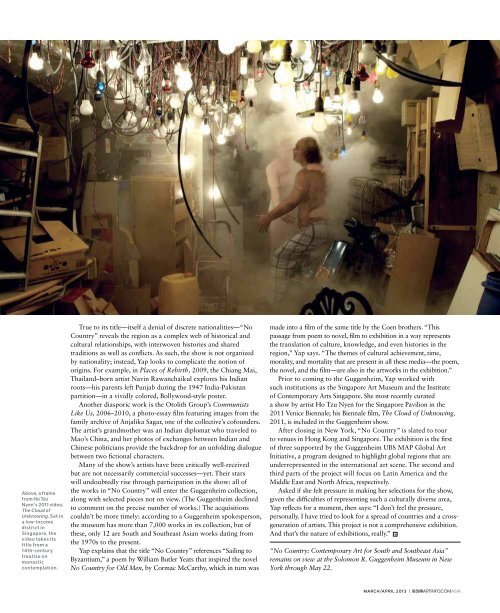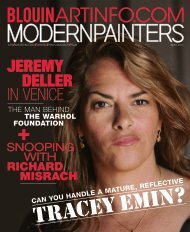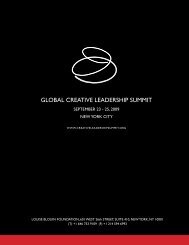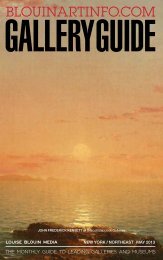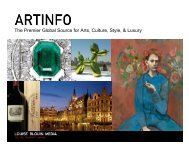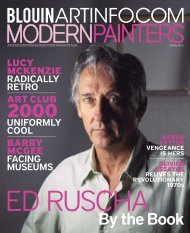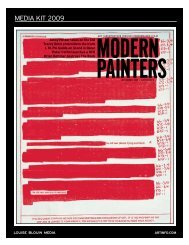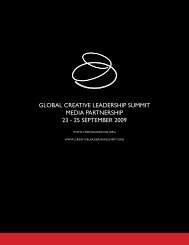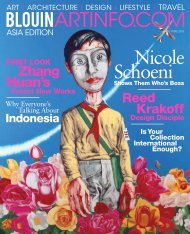Linke - Artinfo
Linke - Artinfo
Linke - Artinfo
You also want an ePaper? Increase the reach of your titles
YUMPU automatically turns print PDFs into web optimized ePapers that Google loves.
Above, a frame<br />
from Ho Tzu<br />
Nyen’s 2011 video,<br />
The Cloud of<br />
Unknowing. Set in<br />
a low-income<br />
district in<br />
Singapore, the<br />
video takes its<br />
title from a<br />
14th-century<br />
treatise on<br />
monastic<br />
contemplation.<br />
True to its title—itself a denial of discrete nationalities—“No<br />
Country” reveals the region as a complex web of historical and<br />
cultural relationships, with interwoven histories and shared<br />
traditions as well as conflicts. As such, the show is not organized<br />
by nationality; instead, Yap looks to complicate the notion of<br />
origins. For example, in Places of Rebirth, 2009, the Chiang Mai,<br />
Thailand–born artist Navin Rawanchaikul explores his Indian<br />
roots—his parents left Punjab during the 1947 India-Pakistan<br />
partition—in a vividly colored, Bollywood-style poster.<br />
Another diasporic work is the Otolith Group’s Communists<br />
Like Us, 2006–2010, a photo-essay film featuring images from the<br />
family archive of Anjalika Sagar, one of the collective’s cofounders.<br />
The artist’s grandmother was an Indian diplomat who traveled to<br />
Mao’s China, and her photos of exchanges between Indian and<br />
Chinese politicians provide the backdrop for an unfolding dialogue<br />
between two fictional characters.<br />
Many of the show’s artists have been critically well-received<br />
but are not necessarily commercial successes—yet. Their stars<br />
will undoubtedly rise through participation in the show: all of<br />
the works in “No Country” will enter the Guggenheim collection,<br />
along with selected pieces not on view. (The Guggenheim declined<br />
to comment on the precise number of works.) The acquisitions<br />
couldn’t be more timely: according to a Guggenheim spokesperson,<br />
the museum has more than 7,000 works in its collection, but of<br />
these, only 12 are South and Southeast Asian works dating from<br />
the 1970s to the present.<br />
Yap explains that the title “No Country” references “Sailing to<br />
Byzantium,” a poem by William Butler Yeats that inspired the novel<br />
No Country for Old Men, by Cormac McCarthy, which in turn was<br />
made into a film of the same title by the Coen brothers. “This<br />
passage from poem to novel, film to exhibition in a way represents<br />
the translation of culture, knowledge, and even histories in the<br />
region,” Yap says. “The themes of cultural achievement, time,<br />
morality, and mortality that are present in all these media—the poem,<br />
the novel, and the film—are also in the artworks in the exhibition.”<br />
Prior to coming to the Guggenheim, Yap worked with<br />
such institutions as the Singapore Art Museum and the Institute<br />
of Contemporary Arts Singapore. She most recently curated<br />
a show by artist Ho Tzu Nyen for the Singapore Pavilion in the<br />
2011 Venice Biennale; his Biennale film, The Cloud of Unknowing,<br />
2011, is included in the Guggenheim show.<br />
After closing in New York, “No Country” is slated to tour<br />
to venues in Hong Kong and Singapore. The exhibition is the first<br />
of three supported by the Guggenheim UBS MAP Global Art<br />
Initiative, a program designed to highlight global regions that are<br />
underrepresented in the international art scene. The second and<br />
third parts of the project will focus on Latin America and the<br />
Middle East and North Africa, respectively.<br />
Asked if she felt pressure in making her selections for the show,<br />
given the difficulties of representing such a culturally diverse area,<br />
Yap reflects for a moment, then says: “I don’t feel the pressure,<br />
personally. I have tried to look for a spread of countries and a crossgeneration<br />
of artists. This project is not a comprehensive exhibition.<br />
And that’s the nature of exhibitions, really.”<br />
“No Country: Contemporary Art for South and Southeast Asia”<br />
remains on view at the Solomon R. Guggenheim Museum in New<br />
York through May 22.<br />
March/april 2013 | Blouin<strong>Artinfo</strong>.comAsiA<br />
From top: the otolith group and project 88, mumbai; reza aFisina; navin rawanchaikul. opposite page: russell morton and ho tzu nyen.<br />
cuRATOR’S INSIGHT<br />
June Yap on 5 Artworks<br />
Poklong Anading (Philippines),<br />
Counter Acts, 2004<br />
In 2004, Anading began a significant<br />
series, “Anonymity,” with this work. In<br />
the series, he persuaded people on the<br />
street to be photographed while<br />
holding circular mirrors in front of<br />
their faces. The photographic gesture<br />
of seizing a moment in time, in which<br />
the act of seeing and the nature of<br />
light dictate the visual result, is<br />
doubled and foiled here. The light from<br />
the sun—reflected in the mirror—<br />
obscures the views of both artist and<br />
subject. In the context of the<br />
exhibition, this visual paradox of sight<br />
and obscurity could be a cue for us to<br />
consider how one views Southeast<br />
Asia both from within and outside the<br />
region (from the United States, for<br />
example) and what we think we might<br />
be observing.<br />
Blouin<strong>Artinfo</strong>.comAsiA | march/april 2013<br />
Ho Tzu Nyen (Singapore),<br />
The Cloud of Unknowing, 2011<br />
The Cloud of Unknowing is named after<br />
a 14th-century mystical treatise<br />
intended as a primer for aspiring<br />
monastics on the art of contemplative<br />
prayer. Thoughtful and enigmatic, Ho’s<br />
film—set in a low-income estate in<br />
Taman Jurong (a residential district in<br />
Singapore)—is a visual and aural<br />
interpretation of the representation of<br />
the cloud across Eastern and Western<br />
cultures. In this work, the lines between<br />
the two cultures are blurred, in the<br />
same way that one cannot quite lay<br />
claim to clouds. While “No Country”<br />
presents artworks relating to a region<br />
of Asia, the distinction between East<br />
and West is deliberately left vague.<br />
Hopefully, this enables us to become<br />
more conscious of how we make such<br />
observations and divisions.<br />
The Otolith Group (London),<br />
Communists Like Us, 2006–2010<br />
The Otolith Group is the duo Anjalika<br />
Sagar and Kodwo Eshun. Their work<br />
Communists Like Us contrasts a<br />
dialogue about political action taken<br />
from Jean-Luc Godard’s 1967 film La<br />
Chinoise with images belonging to<br />
the photographic archive of Anasuya<br />
Gyan-Chand, Sagar’s grandmother.<br />
These documentary images depict<br />
encounters between Indian<br />
politicians and activists, and their<br />
counterparts from the Soviet Union,<br />
China, Japan, and other countries in<br />
Asia in the 1950s and ’60s. The<br />
images from the archive are<br />
significant in showing the extensive<br />
nature of diplomatic relations in<br />
postwar Asia, and what such a history<br />
might mean for us in contemplating<br />
the future of the region.<br />
Navin Rawanchaikul (Thailand),<br />
Places of Rebirth, 2009<br />
Rawanchaikul is a truly cross-cultural<br />
example in Asia. In this artwork, he<br />
traces his ancestry from South Asia’s<br />
1947 partition of India and Pakistan<br />
all the way through to his Thai and<br />
Japanese family in East and<br />
Southeast Asia today. Painted in the<br />
style of a Bollywood movie poster, the<br />
diasporic nature of his family’s story is<br />
depicted in images of the artist’s family<br />
and strangers he encountered in<br />
Pakistan, as well as pictures of India<br />
and Pakistan’s historic split. The title<br />
Places of Rebirth suggests the<br />
possibility of multiple origins and<br />
challenges how identity is constituted.<br />
Reza Afisina (Indonesia),<br />
What..., 2011<br />
This video performance shows the<br />
artist reciting the biblical verses Luke<br />
12:3–11, in which Luke relates Jesus’<br />
warnings against hypocrisy and<br />
stresses the importance of truth and<br />
confession. While reciting, the artist<br />
repeatedly slaps himself, emphasizing<br />
the biblical injunction further through<br />
violence upon his own body. The<br />
artist, who comes from a moderate<br />
Muslim family, here examines the idea<br />
of punishment and violence, and the<br />
physical severity of the performance<br />
provokes feelings of empathy in the<br />
viewer. As Indonesia is a secularly<br />
administered but dominantly Muslim<br />
country, the artist’s work presents<br />
an inclusive picture, where the values<br />
of different religions converge in<br />
human empathy.<br />
Left, a frame<br />
from the<br />
Otolith<br />
Group’s video<br />
Communists<br />
Like Us, 2006-<br />
2010; center,<br />
What . . ., a<br />
2001 video by<br />
Reza Afisina.<br />
In Places of<br />
Rebirth, 2009,<br />
below, Thai<br />
artist Navin<br />
Rawanchaikul<br />
depicts<br />
his personal<br />
history in a<br />
Bollywoodstyle<br />
movie<br />
poster.<br />
63


